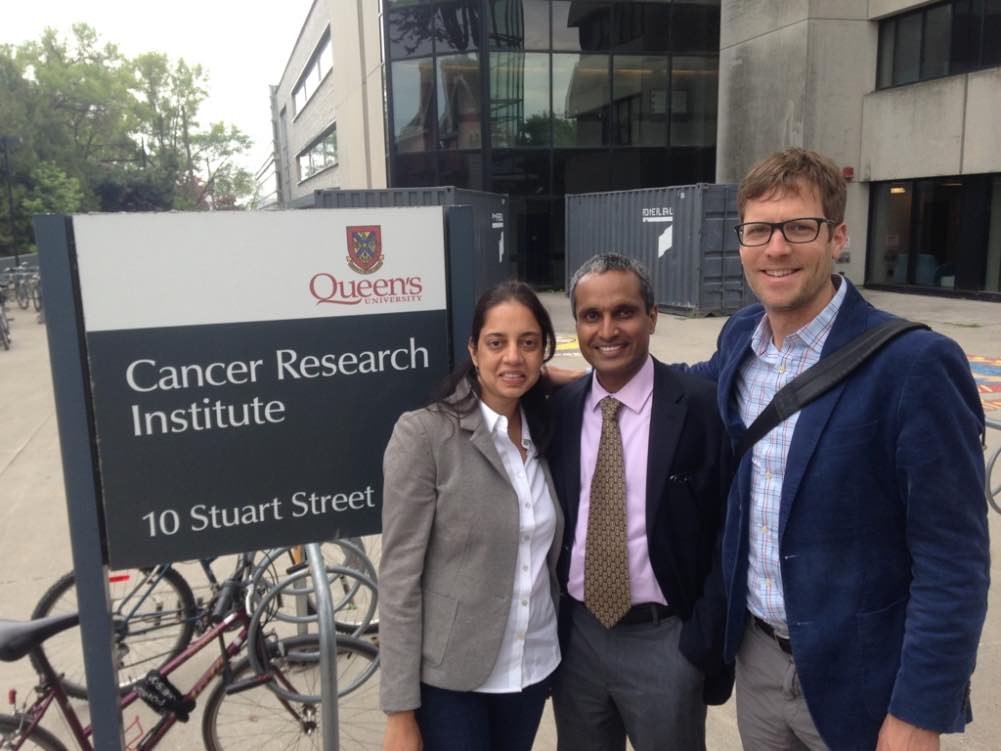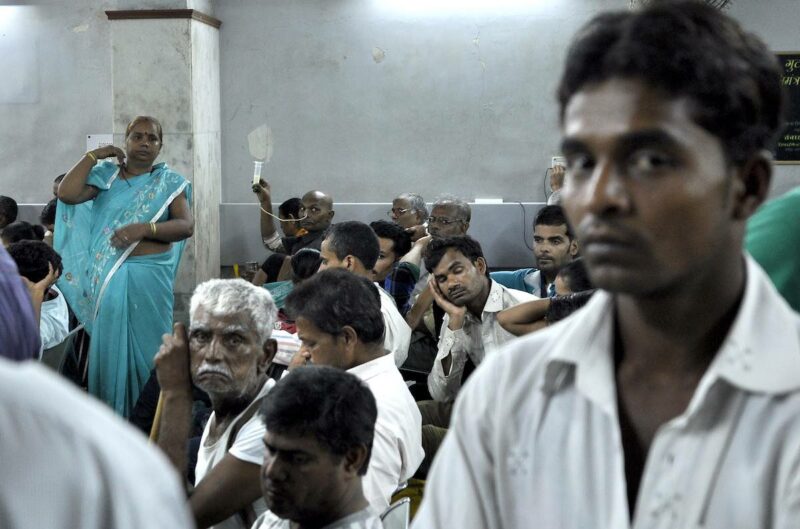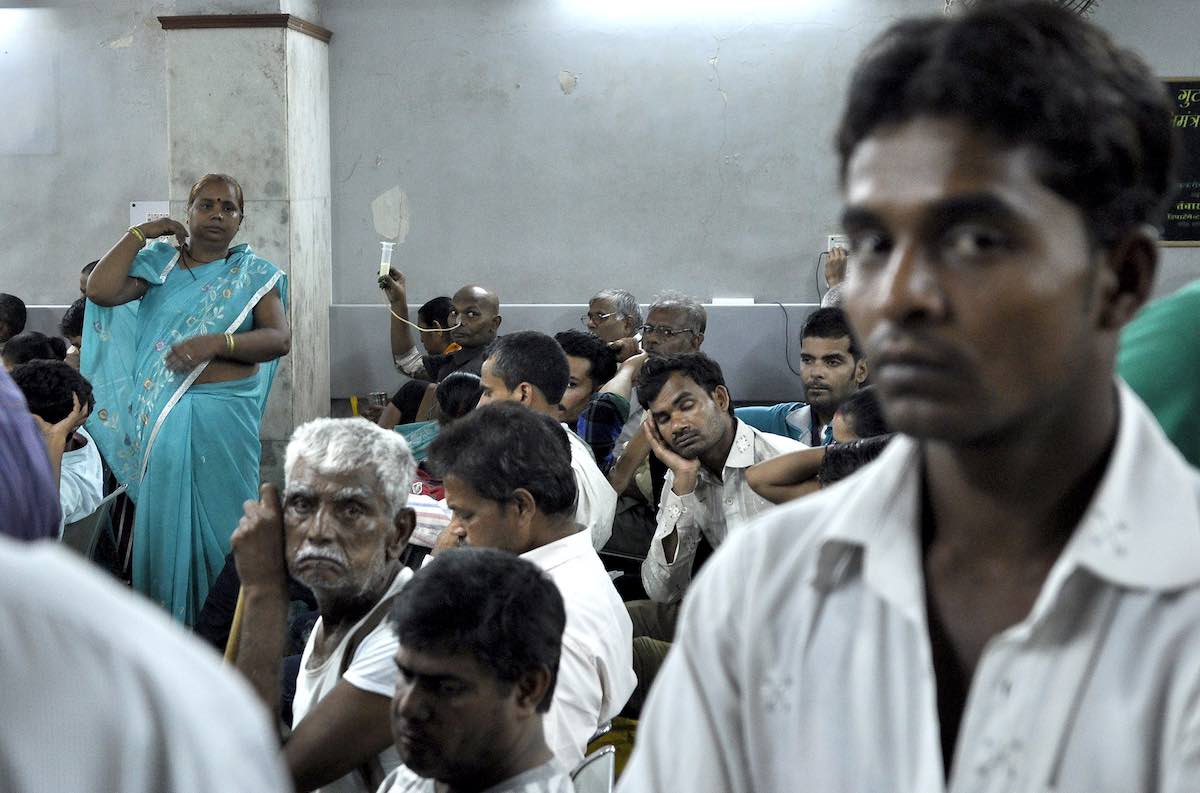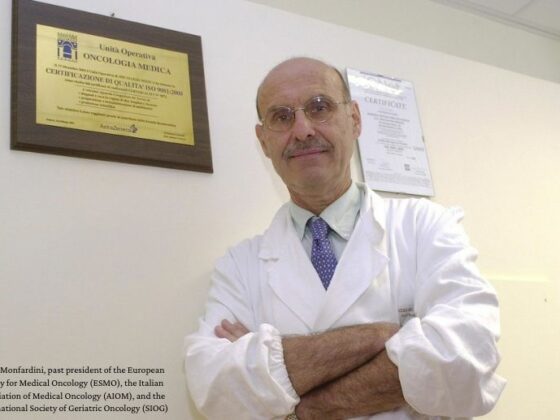When you look at the vast waiting area in Mumbai’s world leading Tata Memorial Cancer Hospital, pictured above, what do you see? A crowded chaotic scene where sick patients and their relatives sit around for hours, waiting, hoping for someone to call their name? That’s certainly part of the story, but as Canadian oncologist and health services researcher Christopher Booth learned in the course of his visits to India, there’s a lot more to scenes like this one than meets the eye.
Every day, huge numbers of patients who have often travelled long distances, turn up without any appointment at public cancer hospitals across India, says Booth. “They might wait all day, but eventually they see the surgeon, who will then walk them down the hall to see the oncologist. On the same day, the patient gets a CT scan, radiation planning and has a PICC line inserted. Treatment starts a few days later.”
Contrast that, he says, with a patient diagnosed, for instance, with colorectal cancer in Canada. “They will get a colonoscopy after months of gastrointestinal bleeding, after which they will be told they have cancer. They will have to wait two weeks to see the surgeon, who will refer them separately to chemotherapy and radiation specialists. The patient will wait several weeks for these consultations. This will be followed by separate appointments for a liver CT, PICC line insertion, and radiation planning. Finally, after many weeks, the patient will start chemotherapy and radiation.”
“Now which system is truly patient centred?” he asks.
Learning from the Global South
Booth, now Director of the Cancer Care and Epidemiology division at Queen’s University, Ontario, Canada, got his first insight into cancer care in a Global South setting when he opted to take a three month sabbatical working at the Regional Cancer Centre, Thiruvananthapuram, in the Indian state of Kerala, on the country’s southwest coast.
The Centre is recognised as an international leader in the delivery of cancer care in low- and middle-income settings, and Booth was there to teach… and learn. “The traditional paradigm of global health is that high-income countries teach low-income countries how to do things, and then they send money. The reality is we can learn just as much from low resource health systems as they can learn from us, we just need the humility to recognise it,” he says.
More isn’t always better
It’s a point echoed by Bishal Gyawali, a medical oncologist of Nepali origin, and colleague of Booth’s at Queen’s, who has a strong international following for his incisive analyses on what claims for the value of new drugs can truly be made on the basis of the clinical trials. Gyawali points to the example of the adaptations that oncology services in the Global North made during the COVID pandemic ‒ shifting some consultations online or by phone to minimise potential exposure to the virus, cutting out imaging and tests and even some drugs that were deemed not worth the added risk.
Cancer services in low-resource countries have always done these things, says Gyawali. Lack of resources is part of the story, but it’s also about minimising the number of appointments and journeys that patients have to make, and freeing up health professionals to spend time with people who need to be seen face to face.
The potential advantages of using more remote consultations and communication, and less imaging, tests and interventions that in many patients convey marginal benefit if any, were listed by many oncologists among the lessons learned from the Covid-19 lockdown (see for instance the Cancer World survey on Lessons from the First Wave).
Could those advantages perhaps have been learned even without the pandemic, had oncology services in better resourced countries ever asked about what they could learn from some countries in the Global South?
A caring, community approach
Then there’s the issue of overcoming the inequities – lower awareness, later stage of diagnosis, poorer access to treatment and follow-up ‒ that combine to explain often fatal differences in outcomes along socioeconomic, ethnic and geographic divides. These are issues in every country and region. But oncologists working in countries where resources are particularly stretched tend to get more involved in trying to mitigate these disparities.
So says Nazik Hammad, a medical oncologist originally from Sudan. Now an associate professor at Queens’s, Ontario, she has been part of building up the University’s growing capacity in Global Health, an area of work she directed for a year in 2019/2020. Her principal interest, however, is in improving training opportunities for young African oncologists. For the past six years she has co-chaired the training committee of AORTIC, the African Organisation for Research and Training in Cancer, and she has been impressed by the responsibility trainees feel for leading change at a societal level.
“They are much more engaged in their communities, while oncologists in higher-income countries are more interested in the latest clinical trials and latest drugs”
“Oncologists [in low- and middle-income countries] play very complex roles, they are leaders and stewards of resources,” she says. They are much more engaged in their communities, with policymakers, while oncologists in higher-income countries are more interested in the latest clinical trials and latest drugs. “For example, oncology residents in Kenya run a volunteer clinic for CML [chronic myeloid leukaemia] patients every Saturday. Others run outreach clinics in neighbouring rural areas, which residents in high-income countries rarely do.” Hammad suggests that working with colleagues in Africa and other Global South countries may lead researchers from better-resourced countries to reflect more on cancer inequities in their own communities.
That sense of responsibility for people beyond one’s own patients is one that Booth recognises from his time at Kerala’s Regional Cancer Centre ‒ a place that provides free and subsidised care to more than 16,000 new patients each year, most of them quite sick with advanced cancers. He talks of being struck by the way that, despite this high patient volume and a gruelling six-day a week, his colleagues not only strived to improve the lives of their patients, but often spent their only free day offering cancer awareness and screening opportunities to some of the most destitute communities in the area.
Despite the sheer number of very sick patents they care for, they still seem to manage to retain their sense of compassion
In a commentary published in JCO Global Oncology, Booth also talks about how working in Kerala helped reaffirm the humanistic ideals that brought him, and so many others, into oncology, in the first place. He highlights studies, showing that almost half of medical oncologists in the US experience burnout ‒ a condition strongly associated with depersonalisation, which can lead to loss of empathy and treating people like objects. And he contrasts this with his experience of the physicians he worked with in Kerala, who, despite the sheer number of very sick patients they care for, still seem to manage to retain their sense of compassion and focus on the human things that matter most.
Could oncology services in high-income countries have anything to learn from that?
While there, Booth also took the opportunity to join the team of health professionals and volunteers who work with Pallium India ‒ Kerala’s world-renowned palliative care organisation ‒ as they travelled the narrow streets of Thiruvananthapuram, providing “comfort in face of scarce resources”. Booth described the experience in his JCO commentary, and wrote of the lessons his own health system might be able to learn.
What impressed him was the remarkable breadth of medical, emotional, and psychosocial problems the teams were able to address. “Pallium pioneered a palliative care model that engages trained volunteers who work alongside physicians and nurses to support patients at home,” says Booth. He believes the system would have “immense benefits in Canada for our many isolated patients and also for the volunteers who would experience a special form of human connection.”
LEARNING TOGETHER
So there’s a lot that oncology in higher income countries can learn from the culture and practices in many lower-income parts of the world. But in terms of the big picture of conquering cancer at a global level, some of the really big gains from learning greater respect for what lower-income countries can contribute are likely to come from enhanced opportunities to learn faster together.
As Gyawali explains, these opportunities relate primarily to research to find sustainable and effective solutions for the 70‒80% of the global population that currently lack access to even basic diagnostic and treatment services or the most basic cytotoxic drugs. This is the so-called cancer groundshot agenda, that Gyawali and others began promoting in response to the 1.8 billion-dollar cancer moonshot initiative, launched by the Obama administration, in 2016, which has a strong focus on high-tech science.
The groundshot approach, as Gyawali explains, focuses on implementation of treatments that are already known to work and incentivising research on affordable and cost effective interventions for cancer control that can be applied globally to reduce cancer morbidity and mortality. This type of research requires strong input from people grounded in the realities of the target countries.
The need to challenge barriers that hold back research in these settings ‒ first-world priorities, attitudes and assumptions, as well as lack of investment in research capacity in more low-resource countries ‒ was highlighted in a previous article on Decolonising cancer research.
Trials conducted across both low/middle-income and high-income settings tend to be of higher quality than trials done in high-income settings alone
But there is a related set of issues around learning how the Global North and South can collaborate effectively in research where all expertise is respected and valued. An interesting analysis published in Nature: Scientific Reports shows that, when measured by the percentage of trials with low risk of bias, the quality of trials conducted in low- and middle-income countries was on average lower than those conducted in high-income countries. However, trials conducted across both low/middle-income and high-income settings tend to be of higher quality than trials done in high-income settings alone. This shows that collaborating on trials can be mutually beneficial for both parties.
For such mutual benefit to be realised, however, requires finding the research questions of mutual interest. As Gyawali and co-authors point out in a commentary in Nature: Cancer, low-resource countries seek to prioritise co-development collaboration on interventions that are affordable and simple to adopt in standard clinical practice, while richer countries are likely to prioritise collaboration on interventions that would also address unmet needs in their own country.
Trials exploring the risk‒benefits of drug offer obvious potential for mutual benefit
Trials exploring the risk‒benefits of drug repurposing ‒ testing drugs approved for other indications within an oncology setting ‒ offer obvious potential for mutual benefit. The Nature: Cancer article references trials of repurposed drugs that have proven to be beneficial for both high- and low/middle-income countries. ASCOLT, for example, a randomised controlled trial testing the risk-benefit of adjuvant aspirin in patients with Dukes C or high-risk Dukes B colorectal cancer, was initiated in Singapore and is now running in more than 65 locations in both high-income and low/middle income countries.
Another large randomised controlled trial, ADD-Aspirin, is currently running in the UK, the Republic of Ireland and India to find out whether regular aspirin use after treatment for an early stage cancer can prevent recurrence of cancer and prevent death. Ensuring adequate patient recruitment is listed as one of the rationales for recruiting in all three countries ‒ India, with its population of almost 1.4 billion, being an obvious asset on the numbers front. Other listed benefits include increasing the global impact of the results ‒ patients in low/middle income countries derive benefit ‒ and “developing research infrastructure for future trials,” which bodes well for future North‒South collaborations.
Gyawali contrasts this mutually beneficial collaboration with predatory practices used in some cancer trials, which use low/middle-income countries to inflate the benefits of their drug by comparing it to a control arm that is no longer standard of care in the target market. “They prove their drug works because control arm patients did not get good treatment, and they get the drug approved in high-income countries, but the patients in low- and middle-income countries can’t access the drug because of its cost,” he says.
A NEW WAY OF WORKING?
Collaboration in oncology has been around for quite a while, says Hammad, but it has become more common over the past five to seven years, with the researchers in the Global South being the initiators. “The young cadre of colleagues [from Africa] are very articulate, showing the world that they can produce reliable research and have a strong voice because they have the numbers and the resources,” she says.
The change is reflected in data on the number of clinical trials taking place in low/middle income countries, which almost quadrupled over 10 years, from 363 in 2007 to 1,389 in 2016 ‒ though is still only one-third the number in high-income countries
Nirmala Bhoo Pathy, Associate Professor of Epidemiology at the University of Malaya, in Kuala Lumpur, recalls instances in the past where western researchers have come in, collected data, secured a large research grant and published, without including the investigators from the region. But she agrees that the situation has improved over the past seven or eight years. She welcomes efforts countries like the UK, a major funder of cancer research, are making to avoid abuse, citing tightened requirements on applicants for Official Development Assistance, which provides government funding for projects in low- and middle-income countries, to demonstrate how their research will benefit the developing country.
She also cites an example from her personal experience, which started when her own University invited the Liam Murray, Director of the Centre for Public Health in Queen’s University, Belfast, to spend some time in Kuala Lumpur as a visiting lecturer. Hearing of her work in clinical epidemiology and prevention, Murray invited Bhoo Pathy back to Belfast, as a visiting lecturer at Queen’s University.
“Somebody was kind enough to acknowledge that there are things to learn from the partners from Asia, and that we can enrich the experiences of their students”
“I think that’s such a heartwarming story, because there was somebody who was kind enough to acknowledge that there are things to learn from the partners from Asia, and that we can bring value and enrich the experiences of their students,” says Bhoo Pathy, who continues in her capacity as a visiting academic at Queen’s, Belfast.
Murray also encouraged Bhoo Pathy to look at the UK Biobank cohort dataset ‒ a large-scale globally accessible resource containing in-depth genetic and health information from half a million participants ‒ to see whether it could help her pursue her research priorities.
The suggestion bore fruit, and Bhoo-Pathy is now the principal investigator of a UK biobank-approved study looking at the association of cancer therapy with cardiovascular-related comorbidities in cancer patients, to improve identification of those patients at greatest risk of cardiovascular complications, and tailor their management accordingly.
While that may be a single example, individual actions can be important in driving broader change. The global oncology programme at Ontario’s Queen’s University is an interesting example of how individual efforts, such as Hammad’s work in Africa and Booth’s work in India, together with other colleagues, organically evolved into the University’s own global oncology programme, which now has links with oncologists across Latin America, Africa and South Asia.

“The team’s work now has many collaborative projects with our colleagues in low- and middle-income countries that focus on health services research, health policy and education, with the aim of improving global equity in cancer care,” says Scott Berry, the University’s head of Oncology. “The focus for us has always been on establishing strong relationships with our partners. We are focussed on finding colleagues with similar goals and identifying and working on projects that address the needs that are the most important for them,” he says.
This kind of collaboration has led, for instance, to the launch of an initiative to study patterns of cancer care at the National Cancer Institute, Sri Lanka (NCISL), which treats one third of all cancer patients in the country. While Sri Lanka’s National Cancer Control Programme maintains a cancer registry, it does not collect data on cancer outcomes. This collaborative initiative involved creating an ‘inception cohort’ ‒ a group of patients with breast and colorectal cancer, who were recruited upon registration at the NCISL. Following this cohort will allow researchers to gain valuable insights into patient demographics, cancer diagnosis, gaps in treatment delivery, outcomes, co-morbidities and health seeking behaviour.
Such an extensive database had not previously been possible due to lack of funding and technical support, says Sanjeeva Gunasekera, a paediatric oncologist at the Sri Lankan National Cancer Institute who works on the project along with Sanjeewa Seneviratne, Professor of Surgery at the University of Colombo, and Don Thiwanka Wijeratne, who is Assistant Professor in Internal Medicine, Queen’s University, Ontario, having moved to Canada from Sri Lanka, where he completed his post graduate training.
This initial collaboration led to developing contacts with oncologists across the world, which in turn has led to multiple other collaborations, says Gunasekera. For their part, Queen’s University’s global oncology team can use the lessons learned from this collaboration as a successful case study to guide collaborative work on similar cohort studies in other low-resource settings, he said.
The road ahead
A change in attitudes and culture remains key to realising the opportunities of more collaborative approaches to mutual learning in oncology. But other barriers will need to be overcome.
Differences in regulatory requirements is one such barrier, which will be familiar to many European researchers who had to navigate their way through the initial EU Clinical Trials Directive. Sunu Cyriac, a medical oncologist at the Amala Institute of Medical Sciences, in Thrissur, Kerala, cites the example of a project planned in partnership with Imperial College, London, which had to be shelved due to India’s stringent laws regarding sharing of biospecimens and data. The project would have involved study of the microbiome in cancer patients, but he could not get approval. India’s stringent financial regulations can also pose an obstacle to receiving research grants from abroad, which makes it difficult for smaller institutions to pursue international collaborative research, he adds.
Along with regulatory requirements, the high cost of conducting trials, logistical challenges associated with ethics review, drug supply, and biospecimen collection and management are all listed as challenges in conducting international clinical trials in cancer, in a 2019 study published in the British Journal of Cancer.
The availability of trained clinical researcher time also remains a huge constraint. As Gyawali points out, doctors in low-resource countries are extremely busy with patient load; they see 10‒20 times more patients than in high-income countries, leaving little time for research work. Supporting the training of new cadres of oncology researchers from the Global South, and funding protected time for clinicians to carry out research work, will both be key to realising the potentially immense progress on the ‘cancer groundshot’ agenda that could be made through more collaborative mutual learning.
Photo: Tushar Mane ©












